Improved Representation of Flow and Water Quality in a North-Eastern German Lowland Catchment by Combining Low-Frequency Monitored Data with Hydrological Modelling
Abstract
1. Introduction
2. Material and Methods
2.1. Study Area
2.2. Data Collection
2.2.1. Climate Data
2.2.2. Land-Use Data
2.2.3. Surface Water Discharge Data
2.2.4. Water Quality and WWTP Effluent Data
2.3. MIKE SHE Process-Based Modelling and Mass Balance Framework
3. Results
3.1. Coupled Hydrological and Hydraulic Model Calibration and Validation
3.2. Water Balance Estimation
3.3. Surface Water and Ground Water Quality
3.4. Nutrient Balance at Catchment Outlet
4. Discussion
4.1. Method Strengths
4.2. Method Weakness
4.3. Transfer of Methodology to Other Lowland Catchments
4.4. Usefulness of Model Predictions and Future Applications
4.5. Key Parameters to Reduce Nitrogen Inputs
5. Conclusions
- By combining a coupled SW/GW model with spatially and temporally scarce grab samples, the dominant nutrient entry pathways can be roughly allocated and quantified.
- Process-based hydrological modelling can help in defining SW and GW quality monitoring locations and schedules.
- The modelling approach can be transferred to similar lowlands, and a calibrated coupled model can be used to identify the priority areas to reduce nutrient pollution. Differences between accumulated loads and measured total loads can be used as rough estimates for instream transformation processes.
Author Contributions
Funding
Acknowledgments
Conflicts of Interest
Appendix A
| Hydrological Processes | ||||
| SWAT | SWIM | HSPF | MIKE SHE | |
| Interception | - | Interception | Interception | |
| Evapotranspiration (ET) | Evapotranspiration | Evapotranspiration | Evapotranspiration | |
| Infiltration (I) | Infiltration | Infiltration | Infiltration | |
| Percolation | Percolation | Percolation | Percolation | |
| Subsurface flow | Subsurface flow | Subsurface flow | Subsurface flow | |
| Baseflow | Baseflow | Baseflow | Baseflow | |
| Surface runoff | Surface runoff | Surface runoff | Surface runoff | |
| Drainage | - | - | Drainage | |
| Pump flow | - | - | Pump flow | |
| Urban drainage | - | - | Urban drainage | |
| Hydraulic processes | ||||
| SWAT | SWIM | HSPF | MIKE SHE and MIKE 11 | |
| - | - | - | River Pumps | |
| - | - | - | Backwater effect | |
| - | - | - | Control structures | |
| - | - | - | Operational strategies | |
| Governing Equations | ||||
| SWAT | ||||
| Runoff volume | Modified Soil Conservation Service (SCS) Curve Number or Green and Ampt infiltration equation | |||
| Peak runoff rate | Rational formula or the SCS TR-55 method | |||
| Subsurface flow and percolation | Kinematic storage routine equation; is based on several input data regarding hillslope, field capacity, the volume of soil water, soil porosity, and hydraulic conductivity | |||
| Potential evapotranspiration |
| |||
| Flow rate and velocity |
| |||
| Sediment yield | Modified Universal Soil Loss Equation | |||
| Flow routing | “Muskingum routing method” or “variable storage routing method” | |||
| SWIM | ||||
| Surface runoff | The non-linear function of precipitation and a retention coefficient | |||
| Subsurface flow | Kinematic storage routine equation | |||
| Potential evapotranspiration | Priestley–Taylor or Penman–Monteith | |||
| Sediment yield | Modified Universal Soil Loss Equation | |||
| HSPF | ||||
| Infiltration | Empirical method based on the type of soil and available storage | |||
| Flow rate and velocity | Manning’s equation | |||
| Flow routing | Kinematic wave routing or storage routing | |||
| MIKESHE | ||||
| Surface runoff | 1D diffusive wave Saint Venant equation | |||
| Unsaturated zone flow |
| |||
| Saturated zone flow |
| |||
| Overland flow | 2D finite difference diffusive wave equation | |||
| Evapotranspiration | Kristensen and Jensen method Two-Layer UZ/ET module | |||
| Flow routing |
| |||
| Difficulties or Limitations | ||||
| SWAT |
| |||
| SWIM |
| |||
| HSPF |
| |||
| MIKE SHE |
| |||
| Input data | ||||
| SWAT | ||||
| Climate | Hydrogeology | Soil data | Land use | Topography |
| Daily precipitation | Groundwater table height | Soil thickness or depth | Land use/land cover | Digital elevation model (DEM) |
| Air temperature (max and min) | Aquifer storage | Bulk density | Leaf area index (LAI) | - |
| Solar radiation | Drainage | Soil moisture content | Plant root depth (RD) | - |
| Wind speed | Irrigation | Soil hydraulic conductivity | - | |
| Evapotranspiration | Saturated hydraulic conductivity | Porosity | - | - |
| Humidity | Groundwater recharge | Soil texture | - | - |
| - | Aquifer specific yield | - | - | - |
| - | Groundwater abstraction rates | - | - | - |
| SWIM | ||||
| Climate | Hydrogeology | Soil data | Land use | Topography |
| Precipitation | Groundwater table height | Soil thickness or depth | Land use/land cover | Digital elevation model (DEM) |
| Air temperature (max, min, and average) | Aquifer storage | Bulk density | Leaf area index (LAI) | - |
| Solar radiation | Drainage | Soil moisture content | Plant root depth (RD) | - |
| Evapotranspiration | Saturated hydraulic conductivity | Soil hydraulic conductivity | - | - |
| - | Groundwater recharge | Porosity | - | - |
| - | Aquifer specific yield | Field capacity | - | - |
| - | - | Wilting point | - | - |
| HSPF | ||||
| Climate | Hydrogeology | Soil data | Land use | Topography |
| Precipitation | surface water storage | Soil thickness or depth | Land use/land cover | Digital elevation model (DEM) or sub-basin area and average slope |
| Air temperature | Aquifer storage | Bulk density | - | |
| Dew point temperature | PH | Soil moisture content | - | |
| Solar radiation | Subsurface flow storage | Soil hydraulic conductivity | - | |
| Wind speed | - | Infiltration capacity | - | - |
| Evapotranspiration | - | Soil texture | - | - |
| Humidity | - | - | - | - |
| Vapor pressure | - | - | - | - |
| MIKE SHE | ||||
| Climate | Hydrogeology | Soil data | Land use | Topography |
| Precipitation | Groundwater table | Geological layers | Land use/land cover | Digital elevation model (DEM) |
| Air temperature | Aquifer storage | Bulk density | Vegetation type | - |
| Solar radiation | Specific yield | Soil moisture content | Vegetation height | - |
| Wind speed | Saturated hydraulic conductivity | Soil hydraulic conductivity | Leaf area index | - |
| Evapotranspiration | Groundwater extraction | Porosity | Root depth | - |
| Humidity | Groundwater recharge rate | Soil texture | - | - |
| Vapor pressure | Drainage | - | - | - |
| Daily sunshine hours | Irrigation | - | - | - |
| - | Depth of the saturated zone | - | - | - |
| - | Capillary storage | - | - | - |
| Spatial and temporal discretization | ||||
| SWAT | SWIM | HSPF | MIKE SHE | |
| Spatial: Flexible, Temporal: Continuous | Spatial: Flexible, Temporal: Daily | Spatial: Flexible, Temporal: Flexible or user-defined time step | Spatial: Flexible, Temporal: Event-based and continuous | |
| Basic Purpose | ||||
| SWAT | SWAT’s principle purpose is to compute runoff and loadings from rural areas and watersheds with intensive agriculture. SWAT evaluates the effects of different management practices and decisions on water resources, as well as agricultural pollutants in large river catchments. | |||
| SWIM | The SWIM model was established to examine the impacts of climate and land-use changes at the regional level. | |||
| HSPF | The HSPF model was developed to simulate both catchment hydrology and water quality. | |||
| MIKE SHE | The key purpose of the MIKE SHE model is the integrated modelling of evapotranspiration, groundwater, surface water, and groundwater recharge. | |||
References
- Lam, Q.D.; Schmalz, B.; Fohrer, N. Assessing the spatial and temporal variations of water quality in lowland areas, Northern Germany. J. Hydrol. 2012, 438, 137–147. [Google Scholar] [CrossRef]
- Schmalz, B.; Springer, P.; Fohrer, N. Variability of water quality in a riparian wetland with interacting shallow groundwater and surface water. J. Plant. Nutr. Soil Sci. 2009, 172, 757–768. [Google Scholar] [CrossRef]
- Krause, S.; Bronstert, A.; Zehe, E. Groundwater–surface water interactions in a North German lowland floodplain–implications for the river discharge dynamics and riparian water balance. J. Hydrol. 2007, 347, 404–417. [Google Scholar] [CrossRef]
- Hesse, C.; Krysanova, V.; Päzolt, J.; Hattermann, F.F. Eco-hydrological modelling in a highly regulated lowland catchment to find measures for improving water quality. Ecol. Model. 2008, 218, 135–148. [Google Scholar] [CrossRef]
- Sophocleous, M. Interactions between groundwater and surface water: The state of the science. Hydrogeol. J. 2002, 10, 52–67. [Google Scholar] [CrossRef]
- Kieckbusch, J.J.; Joachim, S. Nitrogen and phosphorus dynamics of a re-wetted shallow-flooded peatland. Sci. Total Environ. 2007, 380, 3–12. [Google Scholar] [CrossRef]
- Kirschke, S.; Häger, A.; Kirschke, D.; Völker, J. Agricultural Nitrogen Pollution of Freshwater in Germany. The Governance of Sustaining a Complex Problem. Water 2019, 11, 2450. [Google Scholar] [CrossRef]
- de Wit, M.; Behrendt, H.; Bendoricchio, G.; Bleuten, W.; van Gaans, P. The contribution of agriculture to nutrient pollution in three European rivers, with reference to the European Nitrates Directive. Eur. Water Manag. Online 2002, 1–19. [Google Scholar]
- Zhang, W.; Li, H.; Kendall, A.D.; Hyndman, D.W.; Diao, Y.; Geng, J.; Pang, J. Nitrogen transport and retention in a headwater catchment with dense distributions of lowland ponds. Sci. Total Environ. 2019, 683, 37–48. [Google Scholar] [CrossRef] [PubMed]
- Heathwaite, L.; Sharpley, A.; Gburek, W. A conceptual approach for integrating phosphorus and nitrogen management at watershed scales. J. Environ. Qual. 2000, 29, 158–166. [Google Scholar] [CrossRef]
- Hildebrandt, A.; Guillamón, M.; Lacorte, S.; Tauler, R.; Barceló, D. Impact of pesticides used in agriculture and vineyards to surface and groundwater quality (North Spain). Water Res. 2008, 42, 3315–3326. [Google Scholar] [CrossRef]
- Schoumans, O.F.; Chardon, W.J.; Bechmann, M.E.; Gascuel-Odoux, C.; Hofman, G.; Kronvang, B.; Dorioz, J.M. Mitigation options to reduce phosphorus losses from the agricultural sector and improve surface water quality: A review. Sci. Total Environ. 2014, 468, 1255–1266. [Google Scholar] [CrossRef] [PubMed]
- Böhlke, J.K. Groundwater recharge and agricultural contamination. Hydrogeol. J. 2002, 10, 153–179. [Google Scholar] [CrossRef]
- He, B.; Kanae, S.; Oki, T.; Hirabayashi, Y.; Yamashiki, Y.; Takara, K. Assessment of global nitrogen pollution in rivers using an integrated biogeochemical modeling framework. Water Res. 2011, 45, 2573–2586. [Google Scholar] [CrossRef] [PubMed]
- Xue, Y.; Song, J.; Zhang, Y.; Kong, F.; Wen, M.; Zhang, G. Nitrate pollution and preliminary source identification of surface water in a semi-arid river basin, using isotopic and hydrochemical approaches. Water 2016, 8, 328. [Google Scholar] [CrossRef]
- Commission Staff Working Document Executive Summary of the Impact Assessment Accompanying the Document Proposal for a Regulation of the European Parliament and of the Council Laying down Rules on the Making Available on the Market of CE Marked Fertilising Products and Amending Regulations (EC) No 1069/2009 and (EC) No 1107/2009. Available online: https://eur-lex.europa.eu/legal-content/EN/TXT/?uri=CELEX%3A52016SC0065 (accessed on 20 May 2020).
- Directive, N. Nitrate Pollution in the Groundwater Resources of the Public Drinking Water Supply; Water Solutions: Stuttgart, Germany, 2017; pp. 25–35. [Google Scholar]
- Härtel, J. Das EuGH-Urteil vom 21. Juni 2018 zum Versto Gegen die EU-Nitratrichtlinie Durch die Bundesrepublik Deutsch-Land: Seine Relevanz für die Richtlinienkonformität des Neuen Düngerechts; Rechtsgutachten Erstellt im Auftrag des Verbands Kommunaler Unternehmen e.V.: Europa-Universität Viadrina Frankfurt, 2018. Available online: https://www.vku.de/fileadmin/user_upload/Verbandsseite/Themen/Umwelt/21_10_2018_Prof_Dr_Ines_Haertel_Gutachten_EuGH_Urteil_Nitratrichtlinie.pdf (accessed on 10 May 2020).
- Winter, T.C. Relation of streams, lakes, and wetlands to groundwater flow systems. Hydrogeol. J. 1999, 7, 28–45. [Google Scholar] [CrossRef]
- Jiang, S.; Michael, R. Hydrological Water Quality Modelling of Nested Meso Scale Catchments. Ph.D. Thesis, Technische Universität Braunschweig, Braunschweig, Germany, 2014. [Google Scholar]
- Dhami, B.S.; Pandey, A. Comparative review of recently developed hydrologic models. J. Indian Water Resour. Soc. 2013, 33, 34–41. [Google Scholar]
- Gao, L.; Li, D. A review of hydrological/water-quality models. Front. Agric. Sci. Eng. 2014, 1, 267–276. [Google Scholar] [CrossRef]
- Benaman, J.; Shoemaker, C.A.; Haith, D.A. Calibration and validation of soil and water assessment tool on an agricultural watershed in upstate New York. J. Hydrol. Eng. 2005, 10, 363–374. [Google Scholar] [CrossRef]
- Shoemaker, L.; Dai, T.; Koenig, J.; Hantush, M. TMDL Model Evaluation and Research Needs; National Risk Management Research Laboratory: US Environmental Protection Agency: Cincinnati, OH, USA, 2005. [Google Scholar]
- Fehér, J.; Muerth, M. Water Models and Scenarios Inventory for the Danube Region; Report EUR 27357EN; European Commission Joint Research Centre Institute for Environment and Sustainability: Luxembourg, 2015; Available online: https://core.ac.uk/download/pdf/38630655.pdf (accessed on 10 April 2020).
- Ward, G.H.; Jennifer, B. A Survey and Review of Modeling for TMDL Application in Texas Watercourses; Center for Research in Water Resources, University of Texas: Austin, TX, USA, 1999. [Google Scholar]
- Kauffeldt, A.; Wetterhall, F.; Pappenberger, F.; Salamon, P.; Thielen, J. Technical review of large-scale hydrological models for implementation in operational flood forecasting schemes on continental level. Environ. Model. Softw. 2016, 75, 68–76. [Google Scholar] [CrossRef]
- Chen, Y.; Li, W.; Fang, G.; Li, Z. Hydrological modeling in glacierized catchments of central Asia-status and challenges. Hydrol. Earth Syst. Sci. 2017, 21. [Google Scholar] [CrossRef]
- Krysanova, V.; Fred, H.; Rank, W. Development of the ecohydrological model SWIM for regional impact studies and vulnerability assessment. Hydrol. Process. Int. J. 2005, 19, 763–783. [Google Scholar] [CrossRef]
- Waseem, M.; Kachholz, F.; Klehr, W.; Tränckner, J. Suitability of a Coupled Hydrologic and Hydraulic Model to Simulate Surface Water and Groundwater Hydrology in a Typical North-Eastern Germany Lowland Catchment. Appl. Sci. 2020, 10, 1281. [Google Scholar] [CrossRef]
- Waseem, M.; Frauke, K.; Jens, T. Suitability of common models to estimate hydrology and diffuse water pollution in North-eastern German lowland catchments with intensive agricultural land use. Front. Agric. Sci. Eng. 2018, 5, 420–431. [Google Scholar] [CrossRef]
- Jardin, N. Vereinheitlichung und Herleitung von Bemessungswerten für Abwasseranlagen (A 198). In Proceedings of the Regen-und Mischwasserbehandlung Seminar, Würzburg, Technische Akademie Hannover, Germany, 23–24 September 2003. [Google Scholar]
- Kuhn, T. The Revision of the German Fertiliser Ordinance in 2017; No. 1548-2017-3861; Institute for Food and Resource Economics, University Bonn: Bonn, Germany, 2017. [Google Scholar]
- Tränckner, H. KOGGE Kommunale Gewässer Gemeinschaftlich Entwickeln-Ein Handlungskonzept für Kleine Urbane GEWÄSSER am Beispiel der Hanse- und Universitätsstadt Rostock; Universität Rostock: Rostock, Germany, 2018. [Google Scholar]
- Verordnung zum Schutz der Oberflächengewässer (Oberflächengewässerverordnung; OGewV) vom 20. Juni 2016. In: BGBI., 2016, I, S. 1 373). Available online: https://www.gesetze-im-internet.de/ogewv_2016/OGewV.pdf (accessed on 3 May 2020).
- Thompson, J.R. Modelling the impacts of climate change on upland catchments in southwest Scotland using MIKE SHE and the UKCP09 probabilistic projections. Hydrol. Res. 2012, 43, 507–530. [Google Scholar] [CrossRef]
- Singh, C.R.; Thompson, J.R.; French, J.R.; Kingston, D.G.; Mackay, A.W. Modelling the impact of prescribed global warming on runoff from headwater catchments of the Irrawaddy River and their implications for the water level regime of Loktak Lake, northeast India. Hydrol. Earth Syst. Sci. 2010, 14, 1745–1765. [Google Scholar] [CrossRef]
- Butts, M.B.; Overgaard, J.; Graham, D.; Dubicki, A.; Strońska, K.; Szalinksa, W.; Larsen, O. Process-based Hydrological Modelling Framework MIKE SHE for Flood Forecasting on the Upper and Middle Odra. In Proceedings of the ICID 21st European Regional Conference, Frankfurt (Oder),Germany; Slubice, Poland, 15–19 May 2005. [Google Scholar]
- Thai, T.H.; Tri, D.Q. Combination of hydrologic and hydraulic modeling on flood and inundation warning: Case study at Tra Khuc-Ve River basin in Vietnam. Vietnam J. Earth Sci. 2019, 41, 240–251. [Google Scholar] [CrossRef]
- Altaf, Y.; Manzoor, A.; Mohammad, F. Modelling snowmelt runoff in Lidder River Basin using coupled model. Int. J. River Basin Manag. 2020, 18, 167–175. [Google Scholar] [CrossRef]
- Ivanescu, V.; Radu, D. Deriving Rain Threshold for Early Warning Based on a Coupled Hydrological-Hydraulic Model. Math. Model. Civ. Eng. 2016, 12, 10–21. [Google Scholar] [CrossRef]
- Hosseini, M.; Reza, K. A data fusion-based methodology for optimal redesign of groundwater monitoring networks. J. Hydrol. 2017, 552, 267–282. [Google Scholar] [CrossRef]
- Gomo, M.; Vermeulen, D.; Lourens, P. Groundwater sampling: Flow-through bailer passive method versus conventional purge method. Nat. Resour. Res. 2018, 27, 51–65. [Google Scholar] [CrossRef]
- Grath, J.; Scheidleder, A.; Uhlig, S.; Weber, K.; Kralik, M.; Keimel, T.; Gruber, D. The EU Water Framework Directive: Statistical Aspects of the Identification of Groundwater Pollution Trends, and Aggregation of Monitoring Results; Austrian Federal Ministry of Agriculture and Forestry, Environment and Water Management: Vienna, Austria, 2001; Final Report. [Google Scholar]
- Jousma, G.; Roelofsen, F.J. World-Wide Inventory on Groundwater Monitoring; Report nr. GP1; International Groundwater Resources Assessment Center: Delft, The Netherlands, 2004. [Google Scholar]
- Nielsen, D.M.; Gillian, N. The Essential Handbook of Ground-Water Sampling; CRC Press, Taylor and Francis Group: Boca Raton, FL, USA, 2006. [Google Scholar]
- Quevauviller, P.; Fouillac, A.M.; Grath, J.; Ward, R. Groundwater Monitoring; Water Quality Measurements Series; Willey: New York, NY, USA, 2009; p. 428. [Google Scholar]
- Cramer, M.; Rinas, M.; Kotzbauer, U.; Tränckner, J. Surface contamination of impervious areas on biogas plants and conclusions for an improved stormwater management. J. Clean. Prod. 2019, 217, 1–11. [Google Scholar] [CrossRef]
- Yapiyev, V.; Skrzypek, G.; Verhoef, A.; Macdonald, D.; Sagintayev, Z. Between boreal Siberia and arid Central Asia–Stable isotope hydrology and water budget of Burabay National Nature Park ecotone (Northern Kazakhstan). J. Hydrol. Reg. Stud. 2020, 27, 100644. [Google Scholar] [CrossRef]
- Yapiyev, V.; Skrzypek, G.; Verhoef, A.; Macdonald, D.; Sagintayev, Z. A proportionality-based multi-scale catchment water balance model and its global verification. J. Hydrol. 2020, 582, 124446. [Google Scholar]
- Smith, A.; Tetzlaff, D.; Gelbrecht, J.; Kleine, L.; Soulsby, C. Riparian wetland rehabilitation and beaver re-colonization impacts on hydrological processes and water quality in a lowland agricultural catchment. Sci. Total Environ. 2020, 699, 134302. [Google Scholar] [CrossRef] [PubMed]
- Waseem, M.; Tatyana, K.; Jens, T. Groundwater Contribution to Surface Water Contamination in a North German Low Land Catchment with Intensive Agricultural Land Use. J. Water Resour. Prot. 2018, 10, 231. [Google Scholar] [CrossRef][Green Version]
- Lam, Q.D.; Britta, S.; Nicola, F. The impact of agricultural Best Management Practices on water quality in a North German lowland catchment. Environ. Monit. Assess. 2011, 183, 351–379. [Google Scholar] [CrossRef] [PubMed]
- Van Griensven, A.; Meixner, T.; Grundwald, S.; Bishop, T.; Diluzio, A.; Srinivasan, R. A global sensitivity analysis tool for the parameters of multi-variable catchment models. J. Hydrol. 2006, 324, 10–23. [Google Scholar] [CrossRef]
- Lenhart, T.; Eckhardt, K.; Fohrer, N.; Frede, H.-G. Comparison of Two Different Approaches of Sensitivity Analysis. Phys. Chem. Earth Parts A/B/C 2002, 27, 645–654. [Google Scholar] [CrossRef]
- Dahm, C.N.; Grimm, N.B.; Marmonier, P.; Valett, H.M.; Vervier, P. Nutrient dynamics at the interface between surface waters and groundwaters. Freshw. Biol. 1998, 40, 427–451. [Google Scholar] [CrossRef]
- van Geer, F.C.; Kronvang, B.; Broers, H.P. High-resolution monitoring of nutrients in groundwater and surface waters: Process understanding, quantification of loads and concentrations, and management applications. Hydrol. Earth Syst. Sci. 2016, 20, 3619. [Google Scholar] [CrossRef]
- Jia, P.; Liu, R.; Ma, M.; Liu, Q.; Wang, Y.; Zhai, X.; Wang, D. Flash Flood Simulation for Ungauged Catchments Based on the Distributed Hydrological Model. Water 2019, 11, 76. [Google Scholar] [CrossRef]
- Chouaib, W.; Alila, Y.; Caldwell, P.V. On the use of mean monthly runoff to predict the flow–duration curve in ungauged catchments. Hydrol. Sci. J. 2019, 64, 1573–1587. [Google Scholar] [CrossRef]
- Gates, T.K.; Cox, J.T.; Morse, K.H. Uncertainty in mass-balance estimates of regional irrigation-induced return flows and pollutant loads to a river. J. Hydrol. Reg. Stud. 2018, 19, 193–210. [Google Scholar] [CrossRef]
- Vogt, R.J.; Sharma, S.; Leavitt, P.R. Direct and interactive effects of climate, meteorology, river hydrology, and lake characteristics on water quality in productive lakes of the Canadian Prairies. Can. J. Fish. Aquat. Sci. 2018, 75, 47–59. [Google Scholar] [CrossRef]
- Rico, A.; Arenas-Sánchez, A.; Alonso-Alonso, C.; López-Heras, I.; Nozal, L.; Rivas-Tabares, D.; Vighi, M. Identification of contaminants of concern in the upper Tagus river basin (central Spain). Part 1: Screening, quantitative analysis and comparison of sampling methods. Sci. Total Environ. 2019, 666, 1058–1070. [Google Scholar] [CrossRef]
- Ivanovsky, A.; Criquet, J.; Dumoulin, D.; Alary, C.; Prygiel, J.; Duponchel, L.; Billon, G. Water quality assessment of a small peri-urban river using low and high frequency monitoring. Environ. Sci. Process. Impacts 2016, 18, 624–637. [Google Scholar] [CrossRef]
- Jomaa, S.; Aboud, I.; Dupas, R.; Yang, X.; Rozemeijer, J.; Rode, M. Improving nitrate load estimates in an agricultural catchment using Event Response Reconstruction. Environ. Monit. Assess. 2018, 190, 330. [Google Scholar] [CrossRef] [PubMed]
- Jones, C.S.; Wang, B.; Schilling, K.E.; Chan, K.S. Nitrate transport and supply limitations quantified using high-frequency stream monitoring and turning point analysis. J. Hydrol. 2017, 549, 581–591. [Google Scholar] [CrossRef]
- van der Grift, B.; Broers, H.P.; Berendrecht, W.; Rozemeijer, J.; Osté, L.; Griffioen, J. High-frequency monitoring reveals nutrient sources and transport processes in an agriculture-dominated lowland water system. Hydrol. Earth Syst. Sci. 2016, 20, 1851–1868. [Google Scholar] [CrossRef]
- Drake, C.W.; Jones, C.S.; Schilling, K.E.; Amado, A.A.; Weber, L.J. Estimating nitrate-nitrogen retention in a large constructed wetland using high-frequency, continuous monitoring and hydrologic modeling. Ecol. Eng. 2018, 117, 69–83. [Google Scholar] [CrossRef]
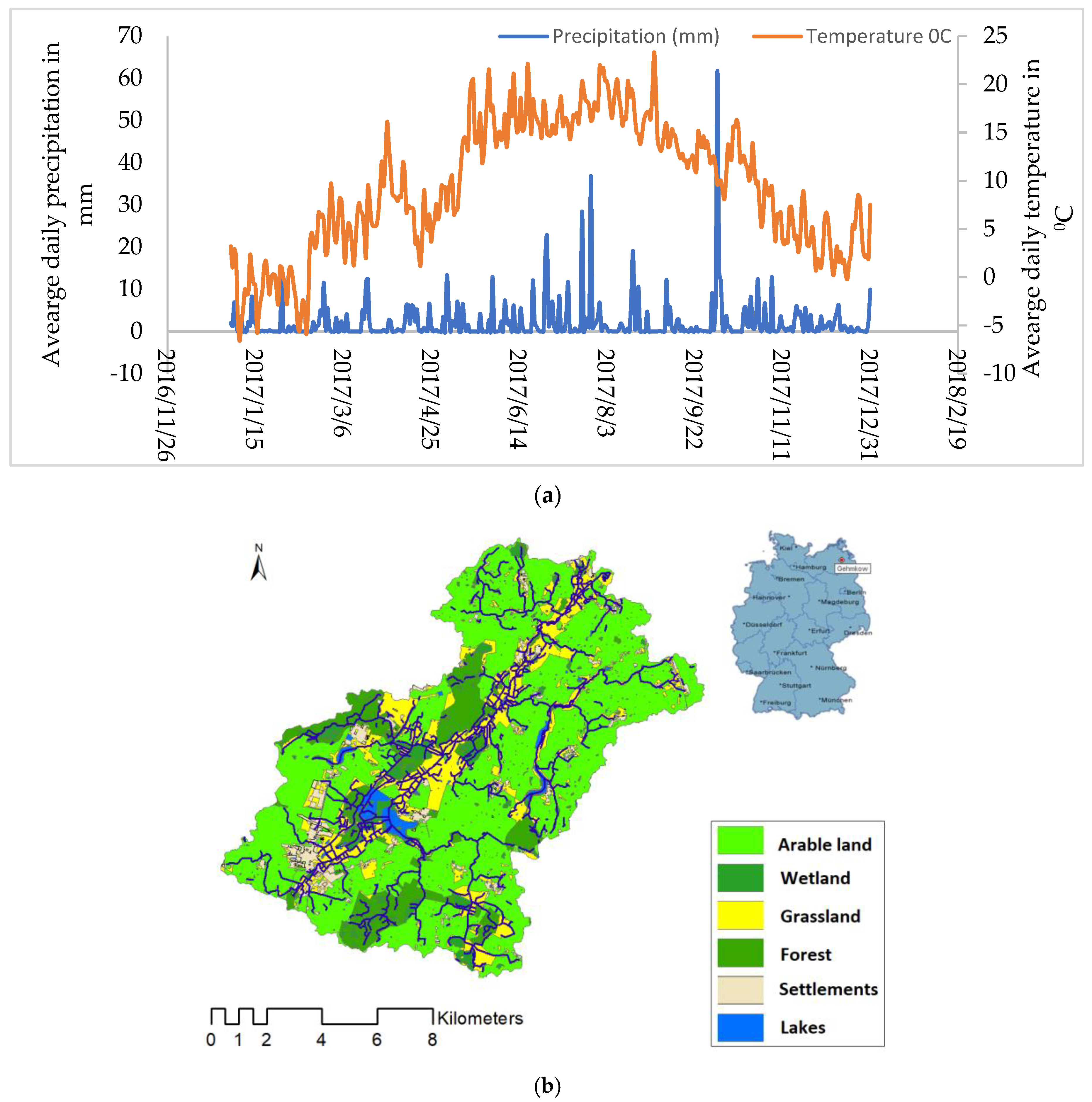
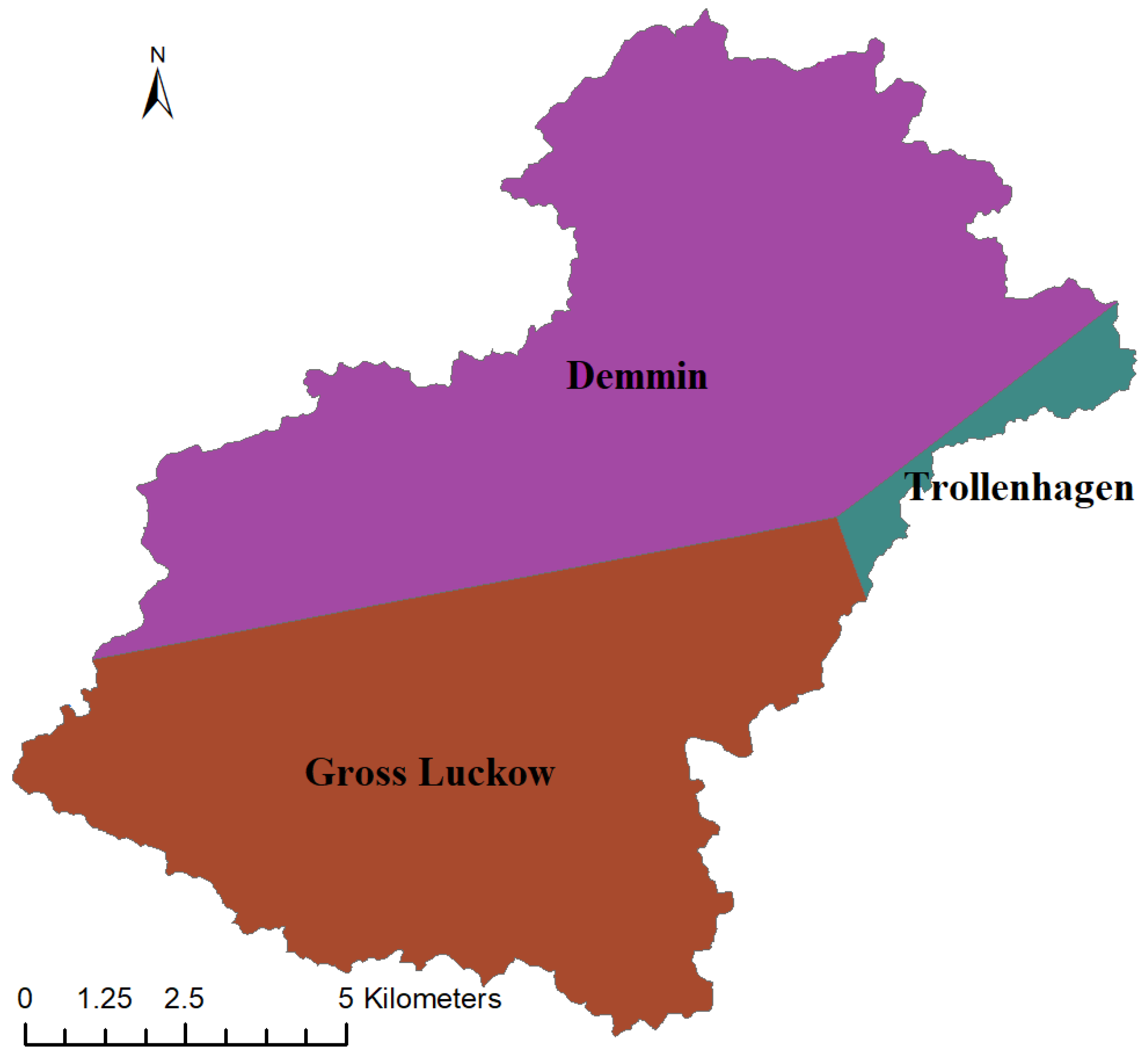
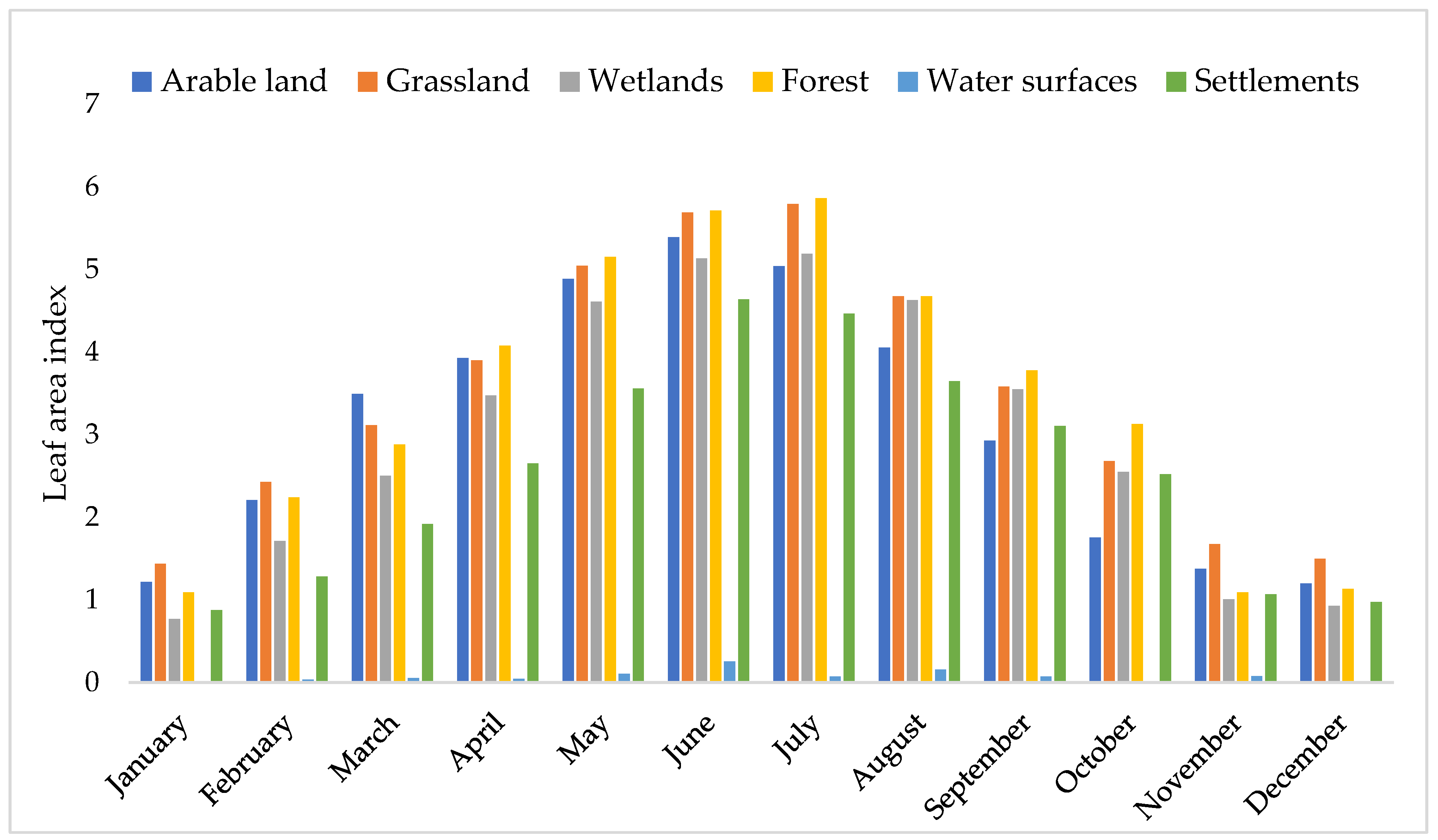
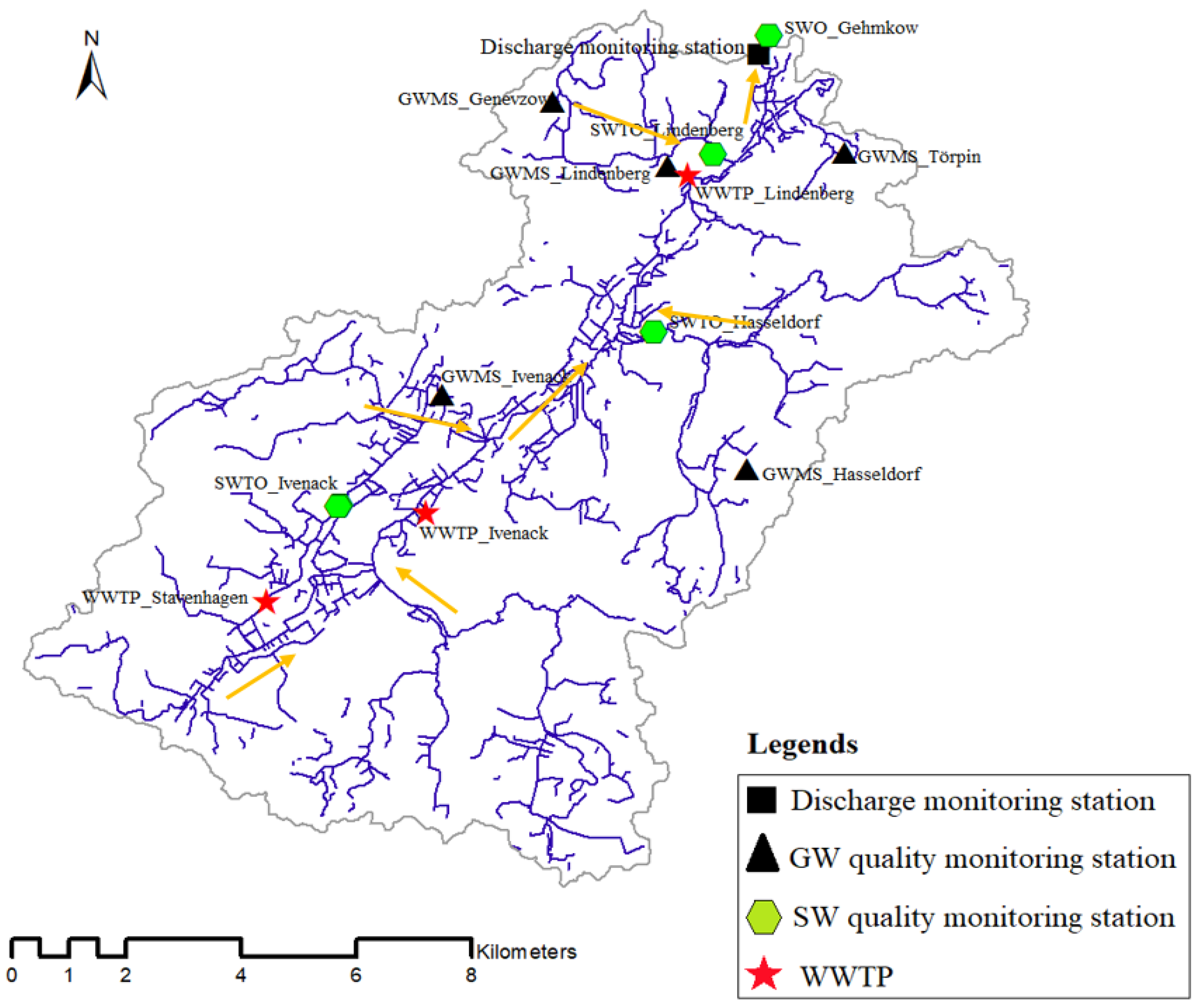
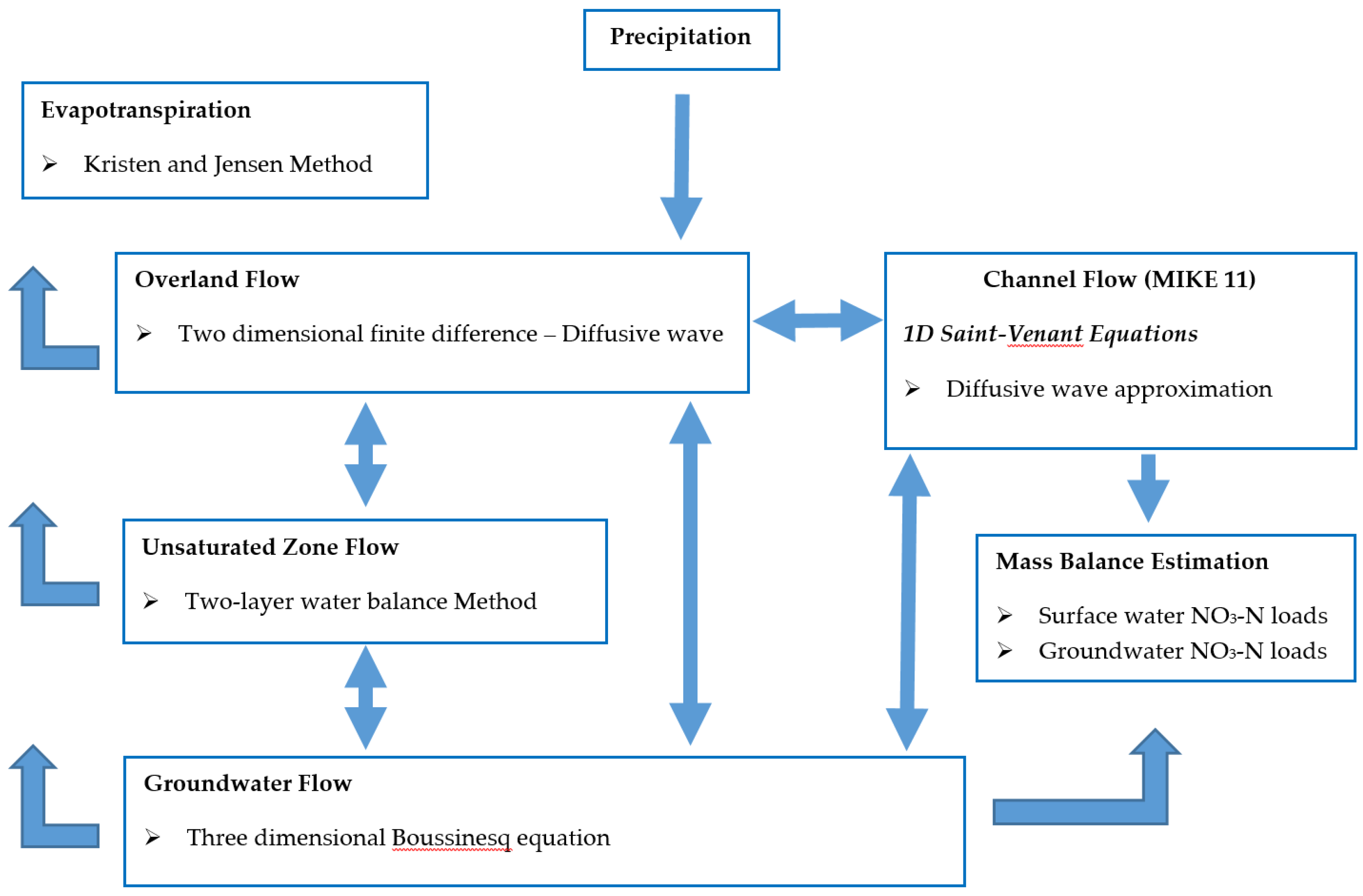
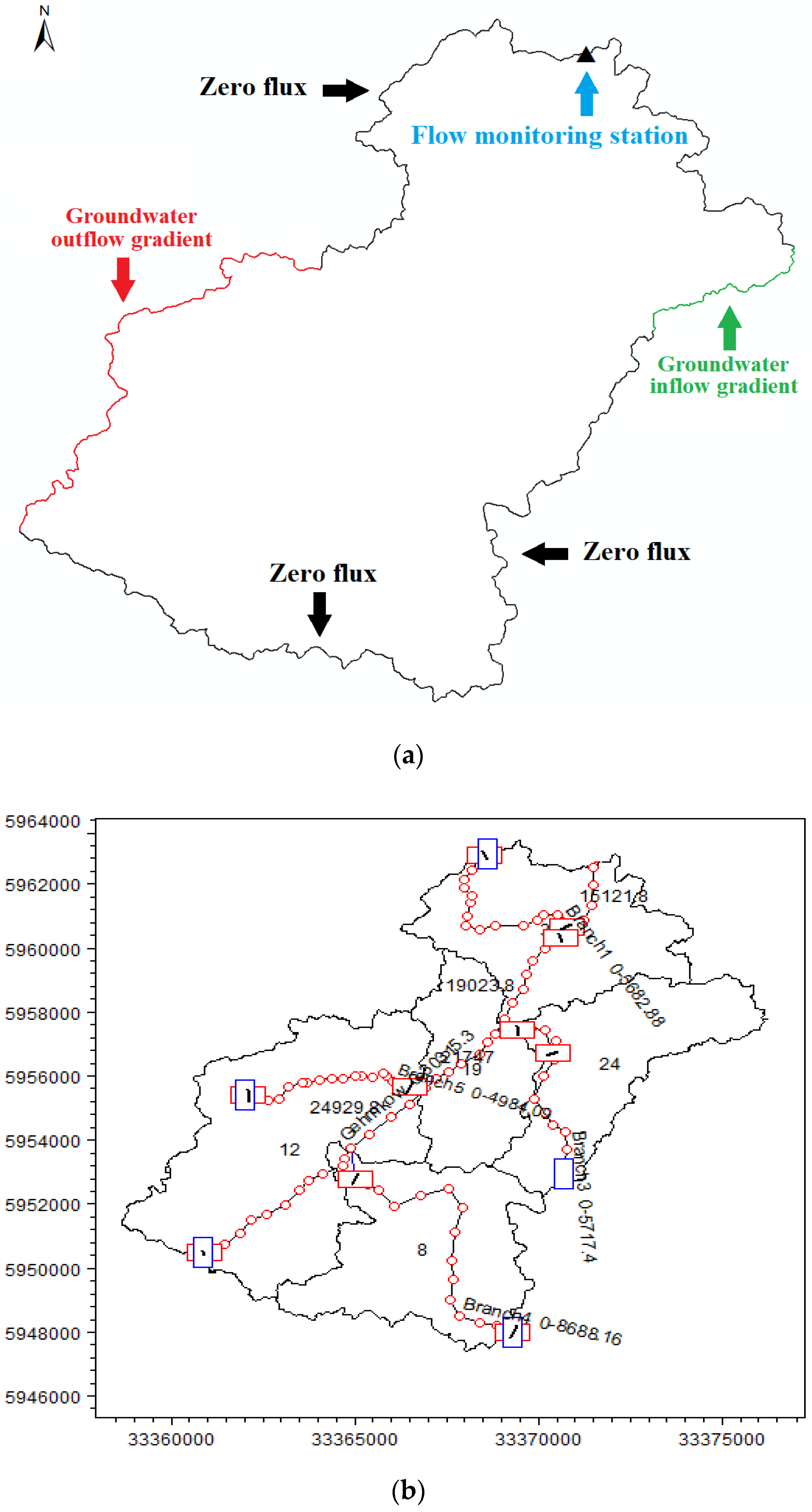
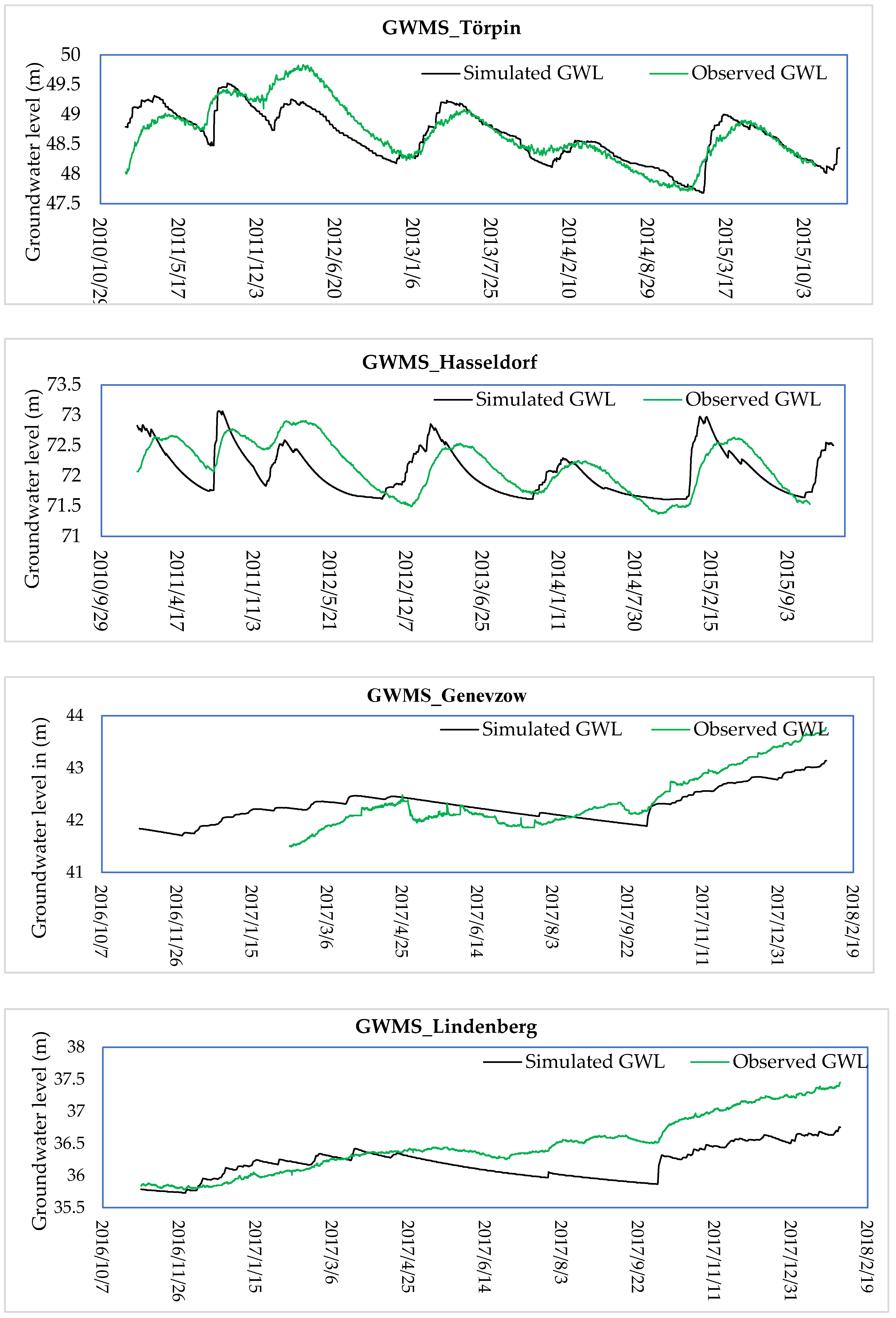
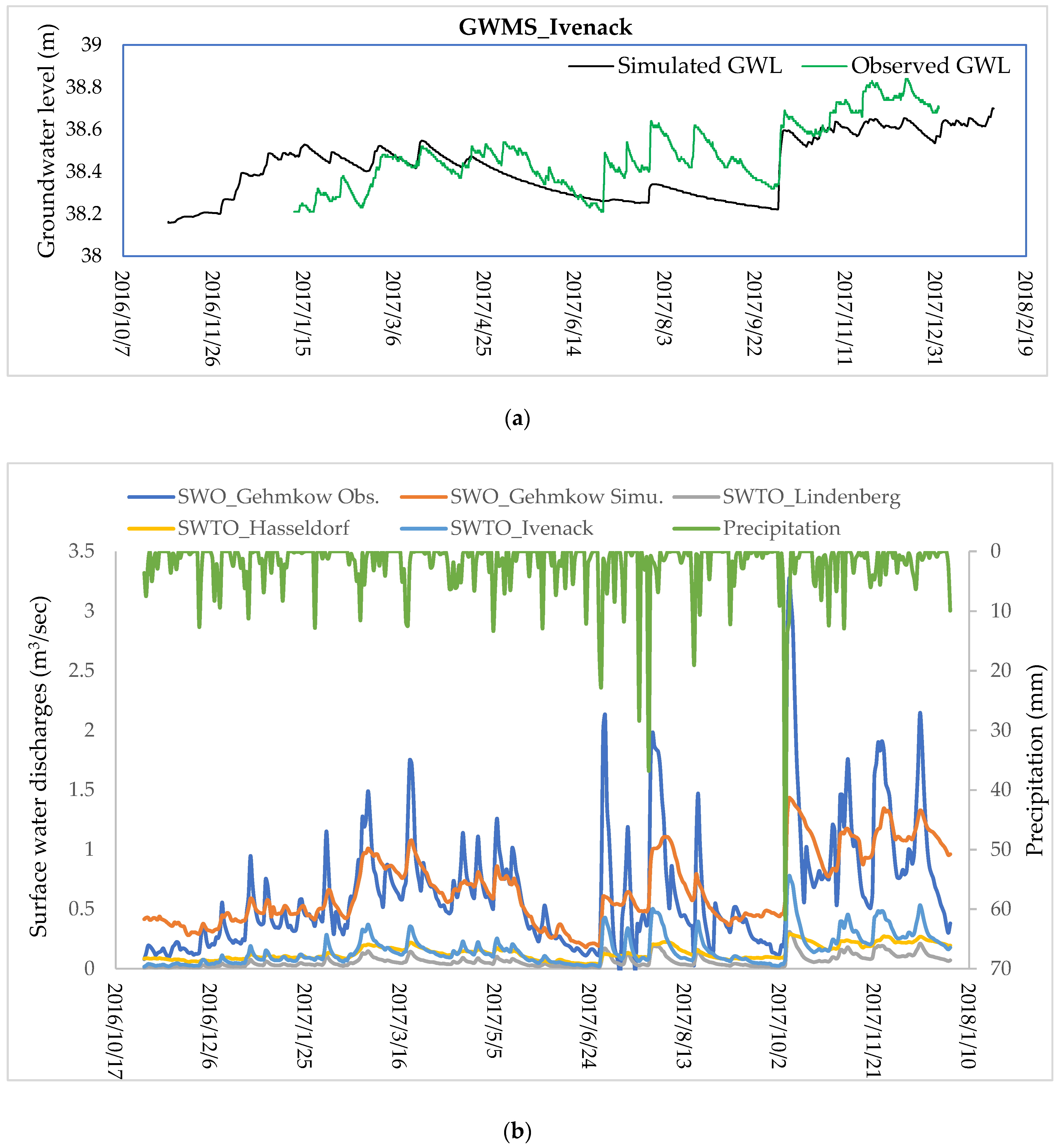
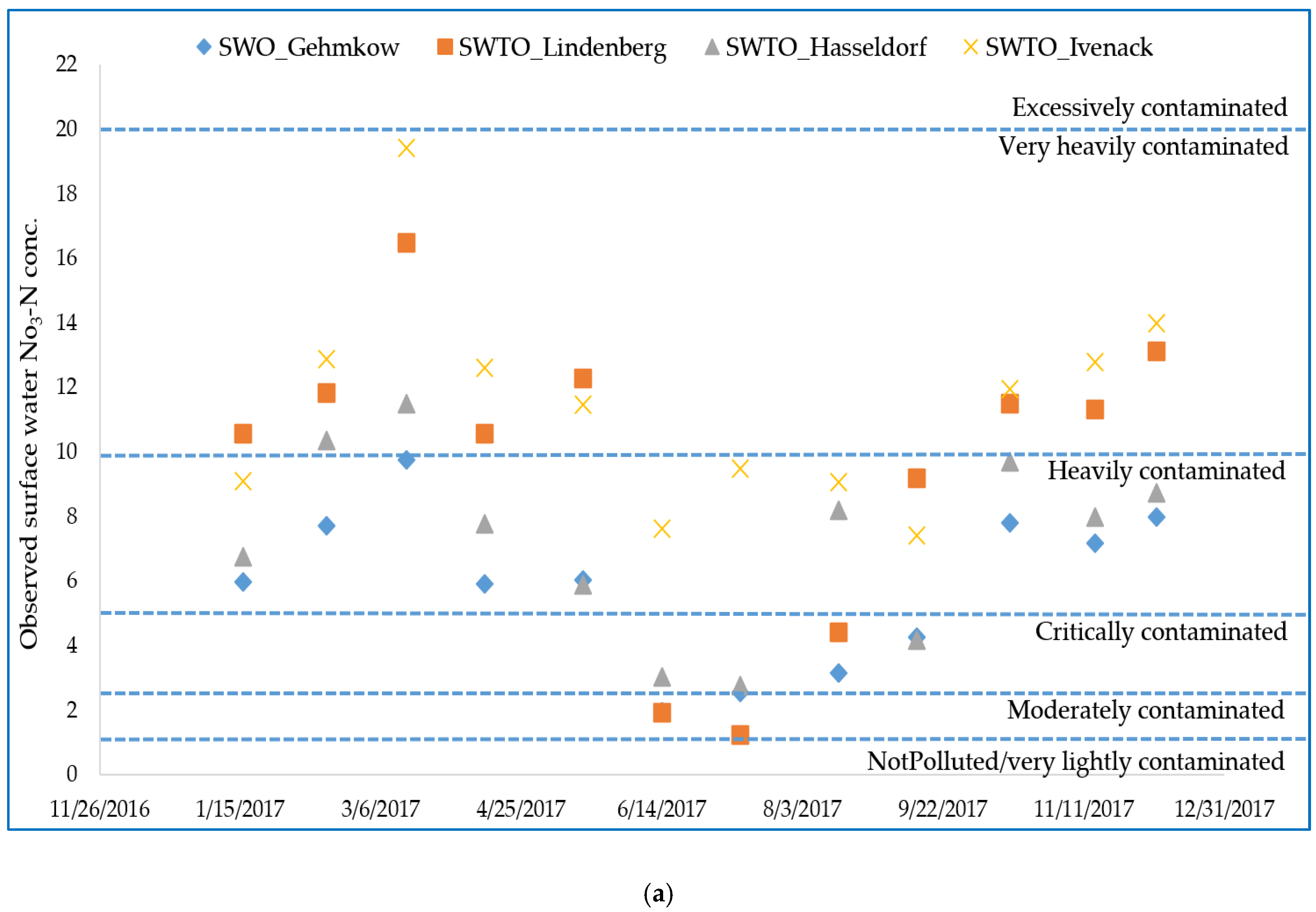
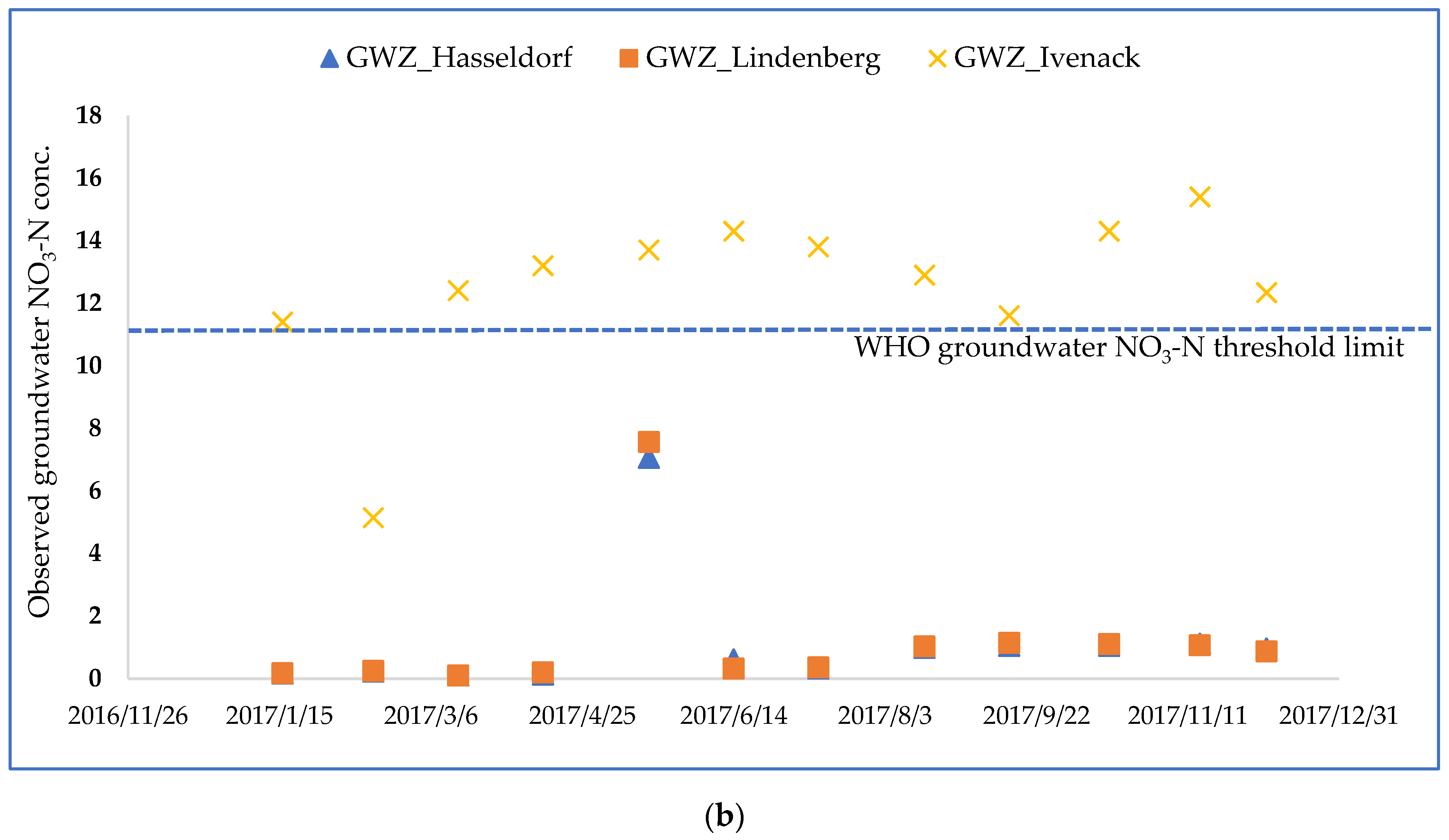
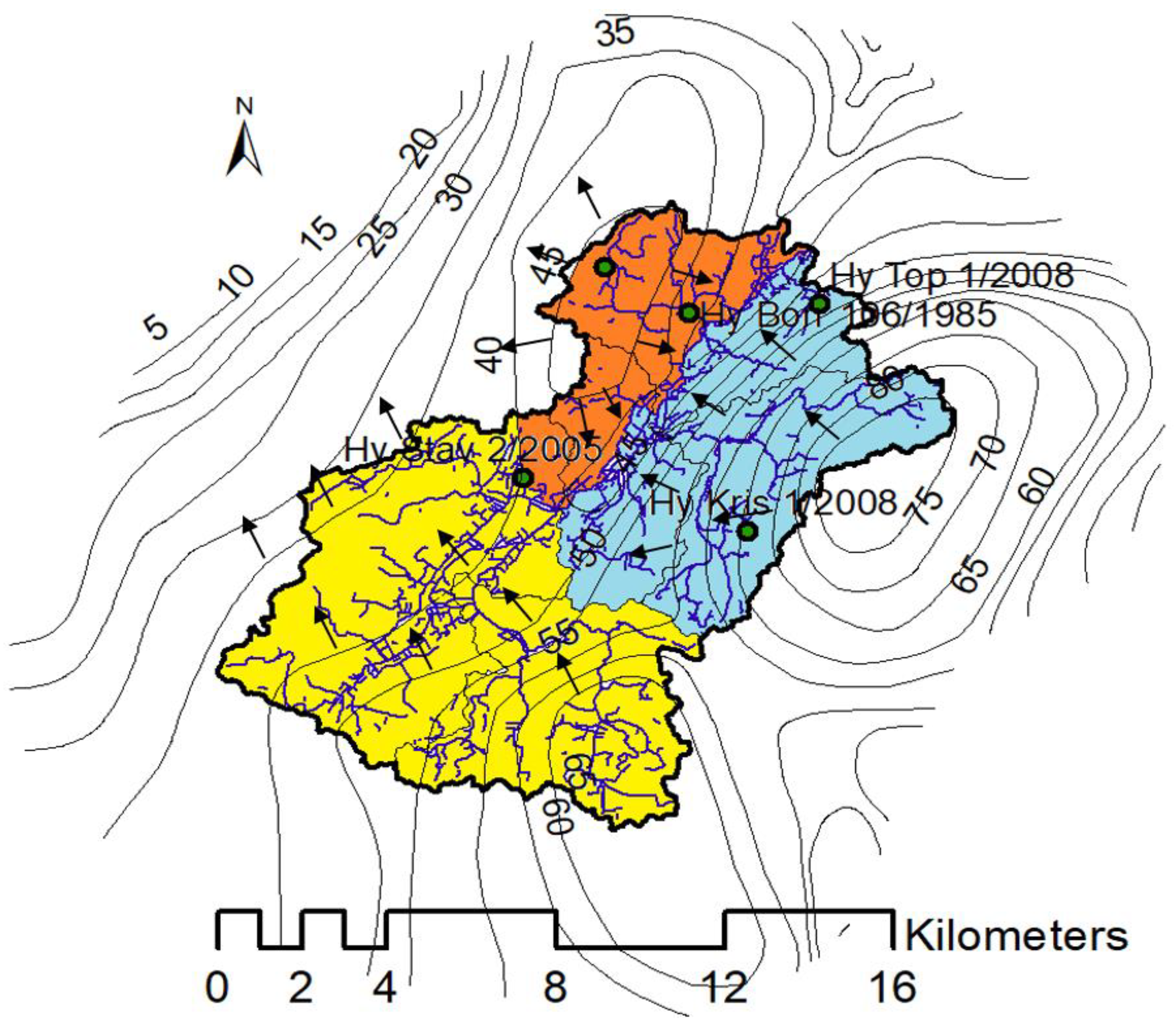
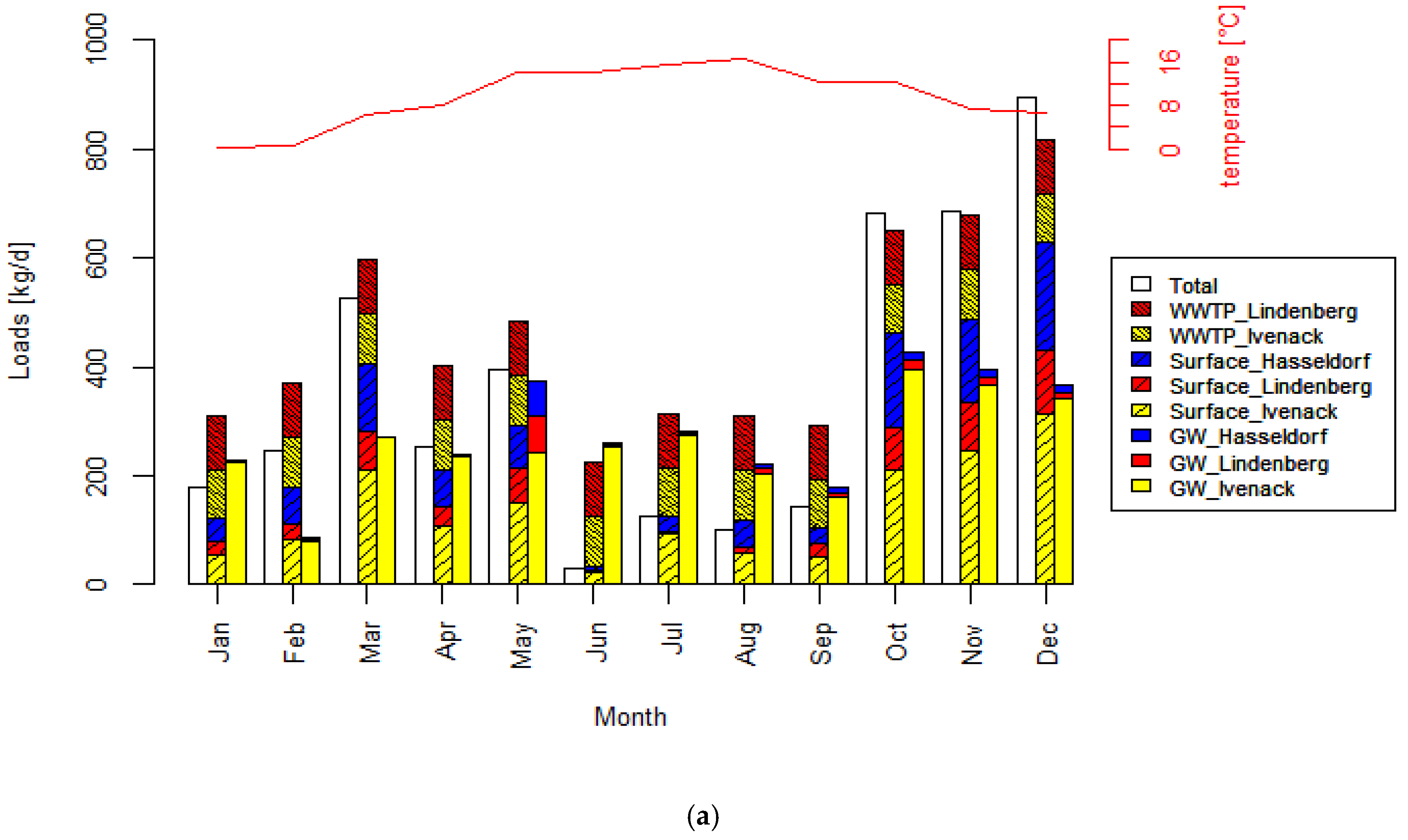
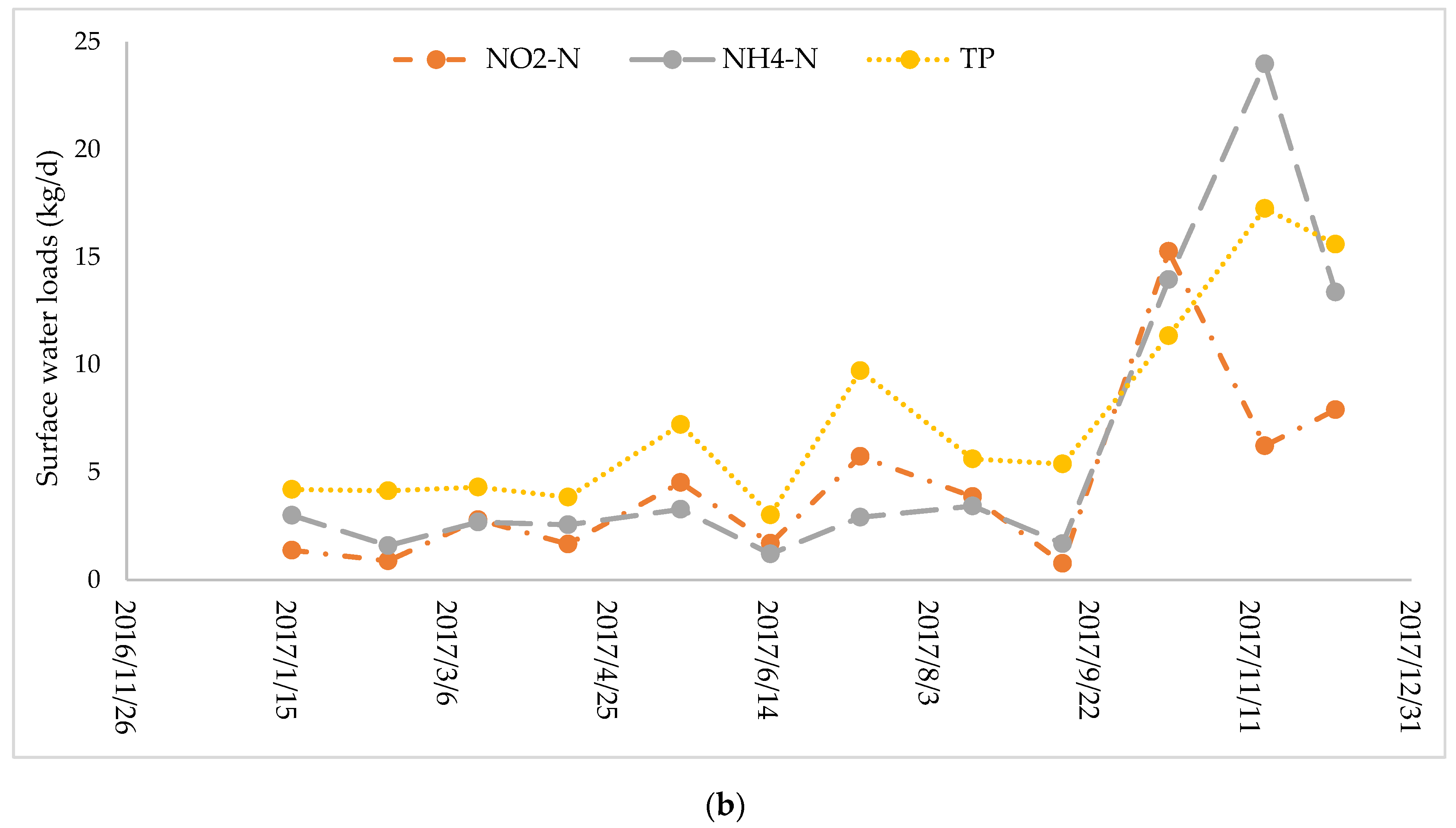
| Standard Emissions | WWTP Lindenberg | WWTP Ivenack | WWTP Stavenhagen | ||||
|---|---|---|---|---|---|---|---|
| Kg/d-inhabitant | kg/d | PE | kg/d | PE | kg/d | PE | |
| COD | 0.12 | 11.60 | 96.72 | 75.90 | 632.52 | 12,510.22 | 104,251.9 |
| N | 0.011 | 1.68674 | 153.34 | 4.09 | 371.86 | 654.280 | 59,480 |
| P | 0.0018 | 0.19 | 107.22 | 0.9951 | 552.8 | 88.304 | 49,058.18 |
| Land-Use | Average Root Depth in Winter (mm) | Average Root Depth in Summer (mm) |
|---|---|---|
| Arable land | 200 | 600 |
| Wetlands | 300 | 300 |
| Grassland | 100 | 300 |
| Forest | 800 | 800 |
| Settlements | 600 | 600 |
| Water surfaces | 0 | 0 |
| Calibration Process | ||||
|---|---|---|---|---|
| Selected Parameters | Initial Input Value | Input Range | Calibrated Value | |
| Hydraulic conductivity [m/s] | A: 1 × 10−6 B: 1 × 10−8 C: 1 × 10−10 | 1 × 10−10–1 × 1010 1 × 10−10–1 × 1010 1 × 10−10–1 × 1010 | 1 × 10−4 1 × 10−7 1 × 10−10 | |
| Specific yield | A: 0.25 B: 0.2 C: 0.1 | 1 × 10−10–1 × 1010 1 × 10−10–1 × 1010 1 × 10−10–1 × 1010 | 0.266 0.20 0.108 | |
| Boundary condition Groundwater inflow and outflow gradients | +ve gradients: 0.0015 −ve gradients: 0.004 | 0.009–−0.009 0.009–−0.009 | 0.0036 −0.004 | |
| Manning roughness coefficient | Natural channel: 10 Weirs or concrete surfaces: 80 | 10–25 80–100 | 15 85 | |
| Statistical performance of groundwater calibration | ||||
| Monitoring Station | MAE (m) | RMSE (m) | R (Correlation) | STDres |
| GWMS_Genevzow | 1.467 | 1.508 | 0.845 | 0.352 |
| GWMS_Ivenack | 1.159 | 1.166 | 0.749 | 0.131 |
| GWMS_Lindenberg | 0.478 | 0.557 | 0.786 | 0.351 |
| GWMS_Hasseldorf | 1.09 | 1.107 | 0.7403 | 0.24 |
| GWMS_Törpin | 1.500 | 1.555 | 0.646 | 0.411 |
| Statistical performance of river flow calibration | ||||
| Monitoring Station | MAE (m3/s) | RMSE (m3/s) | R (Correlation) | STDres |
| SWO_Gehmkow | 0.4514 | 0.5799 | 0.7797 | 0.5299 |
| Water Balance Components (mm) | 2010–2011 | 2011–2012 | 2012–2013 | 2013–2014 | 2014–2015 | 2015–2016 | 2016–2017 | 2017–2018 | 2010–2018 |
|---|---|---|---|---|---|---|---|---|---|
| Precipitation | 804 | 511 | 597 | 573 | 599 | 502 | 767 | 447 | 4814 |
| Evapotranspiration | 473 | 376 | 445 | 456 | 401 | 367 | 482 | 316 | 3324 |
| Canopy storage change | 0 | 0 | 0 | 0 | 0 | 0 | 0 | 0 | 0 |
| Overland flow to the river | 59 | 38 | 37 | 26 | 35 | 34 | 37 | 44 | 311 |
| Snow storage change | 0 | 0 | 0 | 0 | 0 | 0 | 0 | 0 | 0 |
| Overland storage change | 8 | −2 | −4 | 2 | 1 | 0 | 6 | −7 | 5 |
| UZ storage change | −24 | 20 | −6 | 6 | 1 | −26 | 29 | −44 | −42 |
| SZ storage change | 22 | −146 | −80 | −95 | −21 | −50 | 39 | −53 | −388 |
| SZ drain to river | 123 | 90 | 79 | 62 | 68 | 66 | 68 | 79 | 638 |
| Infiltration | 373 | 138 | 182 | 124 | 213 | 180 | 264 | 204 | 1681 |
| Exfiltration | 88 | 61 | 58 | 42 | 54 | 53 | 52 | 68 | 477 |
| UZ boundary inflow | 0 | 0 | 0 | 0 | 0 | 0 | 0 | 0 | 0 |
| UZ boundary outflow | 3 | 1 | 1 | 1 | 1 | 1 | 2 | 2 | 13 |
| SZ boundary inflow | 61 | 55 | 50 | 43 | 43 | 42 | 38 | 43 | 377 |
| SZ boundary outflow | 202 | 187 | 175 | 159 | 155 | 152 | 143 | 152 | 1330 |
© 2020 by the authors. Licensee MDPI, Basel, Switzerland. This article is an open access article distributed under the terms and conditions of the Creative Commons Attribution (CC BY) license (http://creativecommons.org/licenses/by/4.0/).
Share and Cite
Waseem, M.; Schilling, J.; Kachholz, F.; Tränckner, J. Improved Representation of Flow and Water Quality in a North-Eastern German Lowland Catchment by Combining Low-Frequency Monitored Data with Hydrological Modelling. Sustainability 2020, 12, 4812. https://doi.org/10.3390/su12124812
Waseem M, Schilling J, Kachholz F, Tränckner J. Improved Representation of Flow and Water Quality in a North-Eastern German Lowland Catchment by Combining Low-Frequency Monitored Data with Hydrological Modelling. Sustainability. 2020; 12(12):4812. https://doi.org/10.3390/su12124812
Chicago/Turabian StyleWaseem, Muhammad, Jannik Schilling, Frauke Kachholz, and Jens Tränckner. 2020. "Improved Representation of Flow and Water Quality in a North-Eastern German Lowland Catchment by Combining Low-Frequency Monitored Data with Hydrological Modelling" Sustainability 12, no. 12: 4812. https://doi.org/10.3390/su12124812
APA StyleWaseem, M., Schilling, J., Kachholz, F., & Tränckner, J. (2020). Improved Representation of Flow and Water Quality in a North-Eastern German Lowland Catchment by Combining Low-Frequency Monitored Data with Hydrological Modelling. Sustainability, 12(12), 4812. https://doi.org/10.3390/su12124812






